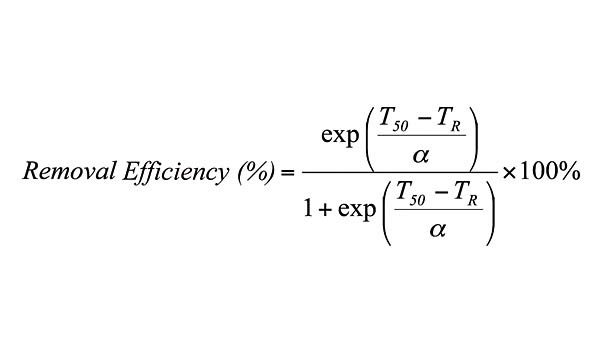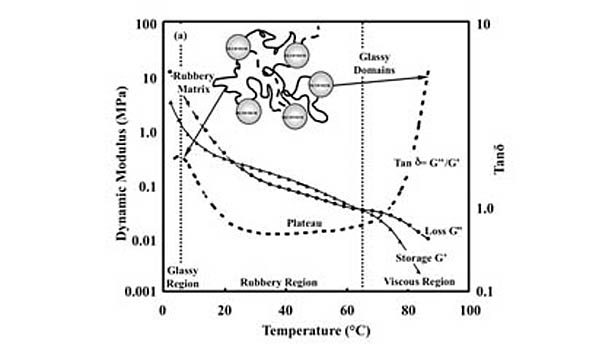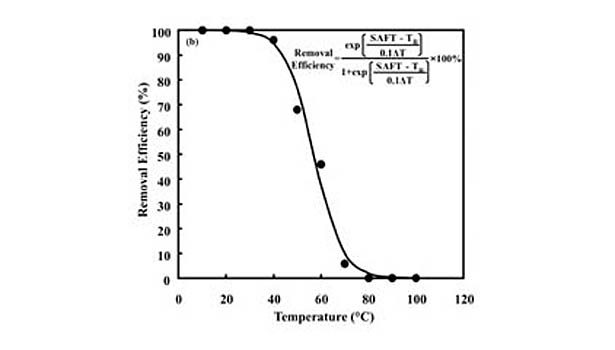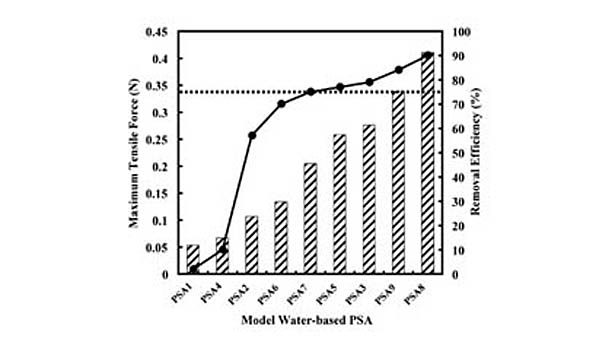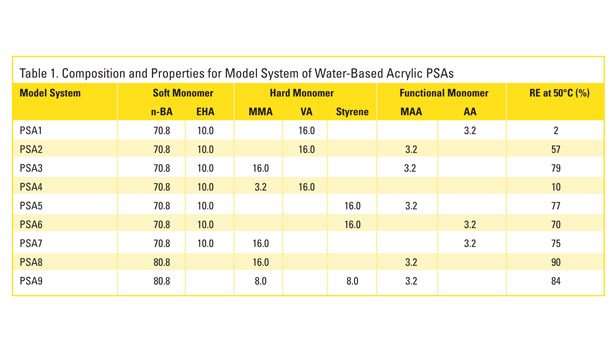IMPACT OF THE COATING PACKAGE
Pressure-sensitive labels are commonly manufactured with water-based PSA via transfer coating involving the coating of latex onto a release liner and drying it to produce the adhesive film. Given that the silicone release liner will have surface energies in the range of 20-35 mJ/m2, casting uniform coatings requires that the surface tension of the aqueous dispersion be reduced, which is the role of the wetting agent.
Other components commonly added to the coating package include defoamers and rheology modifiers. In screening, these additives did not appear to have a significant impact on the removal efficiencies of formed PSA films at typically used levels. It was also found that the emulsifiers used in the synthesis of PSA latexes do not substantially impact fragmentation behavior at their levels. However, wetting agents do impact removal efficiencies for some PSAs.
Figure 4 shows the screening removal efficiencies for model water-based acrylic PSAs 1, 7 and 8 from Table 1. It can be seen that the wetting agent has a substantial impact on the removal efficiency of PSA 7, a small affect on that of PSA 8 and little or no impact on that for PSA 1.
These differences have been explained by identifying two major factors that govern, in large part, the extent to which PSAs fragment during repulping operations.19 The first is the underlying strength of the film, which can be quantified via measurements such as wet-tensile tests. The second, most prevalent factor is the morphology of the film during repulping operations. It appears that the more collapsed the film, the larger the residual particles. Evidence for this can be found in optical images of residual particles from repulping operations obtained for various surfactant concentrations (see Figure 5).
Returning to the observations outlined in Figure 4, a comparison of the wet tensile strengths for the three water-based acrylic PSAs shows that PSA 8 is substantially stronger than PSA 7, which is much stronger than PSA 1. The addition of a wetting agent did not have a significant impact on the wet-strength of films, and the morphologies of all three PSAs were changed in a similar fashion. These results indicate that PSAs with strong and weak intrinsic strengths are relatively unaffected by changes in film morphology. That is, the strongest films break down little, and the weakest are highly fragmented during repulping regardless of their morphology.
Only those PSAs possessing modest strength are significantly impacted by surfactants. It should be stressed that it is not just the wetting agent that can influence removal efficiencies. For example, tackifying dispersions contain 2-4% surfactant. It has been shown that for highly tackified water-based acrylic films, the surfactant used to stabilize the tackifier dispersion has a significant impact on the removal efficiencies of adhesive films.
FACESTOCK IMPACT
For hot-melt PSAs, the facestock properties are of great importance in determining screening removal efficiencies. (This has been discussed in detail in previous publications.20,21) As with the effect of surfactants in water-based systems, paper facestock additives can inhibit the collapse of adhesive films during repulping operations, leading to greater fragmentation.
This effect is most prevalent in PSAs that possess modest strengths. Fragmentation behavior for those adhesives possessing the highest and lowest strengths tends to be unaffected by morphology changes induced by the facestock. Although not discussed here, the facestock influence is mostly absent for water-based acrylic due the presence of surfactant, which tends to promote the removal of facestock fiber from PSA film surfaces.20
SUMMARY
With regard to hot-melt PSA, it is the thermal locations of the phase transitions involving the styrene (end) blocks that determine the extent to which the PSA fragments during recycling operations. Formulation of hot-melt PSAs to thermally move this transition to higher temperatures will increase their screening removal efficiencies. Also, removal efficiencies for hot-melt PSA can be estimated using their SAFT and a quantity extracted from DMA temperature sweeps, which are already commonly measured in the industry. For water-based acrylics, the extent of fragmentation is determined primarily by their wet strength.
Making relatively minor modifications to the monomer composition of the adhesive polymer can produce substantial changes in screening removal efficiencies. Surfactants used in water-based acrylics are shown to influence fragmentation during repulping. The presence of amphilphilic species of any kind, including emulsifiers, wetting agents or surfactants added by recyclers to aid in fiberization and deinking, can reduce screening removal efficiencies. While surfactants are not commonly used in hot-melt formulations, they may be added during recycling and will have a similar impact.
The goal of this presentation is not to provide specific recipes for recycling compatible PS products. Rather, general guidelines are provided that will help direct the synthesis, formulation and product design to produce more recycling compatible PS products. These guidelines are already in use by the industrial partners of this project and have led to the development of a number of commercially available glues and label designs.
Through testing at the Forest Products Laboratory, the PSA films in these products have shown a strong resistance to fragmentation and high screening removal efficiencies. It appears that this can be accomplished while continuing to meet customer specifications, including cost. It is hoped that the future will see a widespread trend toward the incorporation of these design criteria in all PS products that may potentially become incorporated into recovered waste paper.
For more information, contact Steven Severtson at sever018@umn.edu.
ACKNOWLEDGEMENTS
This research was supported by the U.S. Department of Energy, project numbers DE-FC36-04GO14309 and DE-FC07-00ID13881.
REFERENCES
1. Stratton, Robert A., “The Flotation of Sticky Contaminants from Recycled Fiber Streams,” Prog. Pap. Recycl., 1 (4), 1992, pp. 31-37.
2. Li, Chin; Hipolit, Kevin; and Longhini, David A., “Removal of Stickies and Electrostatic Inks Using Flotation Process,” in 1996 TAPPI Recycling Symposium, New Orleans, March 1996; TAPPI Press: Atlanta, 2000; Vol. 1, pp. 21-25.
3. Bloembergen, Steven; McLennan, Ian J.; Cassar, Scott E.; and Narayan, Ramani, “Polymer Resins Designed for Environmental Sustainability,” Adhesives Age, 41(2), 1998, pp. 20-24.
4. Severtson, Steven J.; Wang, Xin-Ping; and Kroll, Mark S., “Development of Environmentally Benign Pressure-Sensitive Adhesive Systems via Modification of Substrate Properties,” Ind. Eng. Chem. Res., 41(23), 2002, pp. 5668-5675.
5. Houtman, Carl J.; Seiter, Daniel; Sutherland, Nancy Ross; and Donermeyer, Donald, “Can Laboratory and Polit Recycling Trials Predict Adhesive Removal in Commercial Recycling System? Results from the USPS Environmentally Benign Stamp Project,” in 2002 TAPPI Fall Conference and Trade Fair, San Diego, September 2002; TAPPI Press: Atlanta, 2002, pp. 28-33.
6. McCaslin, Paul C., “Developing Pressure-Sensitive Adhesives that Can be Removed During Paper Recycling Operations,” in 2000 TAPPI Recycling Symposium, Washington, D.C., March 2000; TAPPI Press: Atlanta, 2000; Vol. 1, pp. 103-110.
7. Guo, Jong-Shing; Ojunga, Andrew M.; Trembley, Sharon D.; Webster, Dennis E.; and Chen, Augstin T., “A Novel Approach in the Design of an Environmentally Benign Emulsion Adhesive,” in 2000 TAPPI Recycling Symposium, Washington, D.C., March 2000; TAPPI Press: Atlanta, 2000, Vol. 1, pp. 95-101.
8. Tag and Label Manufacturers Institute Inc., www.tlmi.com/recycling-standards.php.
9. Mahendra, Doshi R.; Moore, William J.; Venditti, Richard A.; Copland, Kevin; Chang, Hou-min; Putz, Hans-Joachim; Delagoutte, Thierry; Houtman, Carl J.; Tan, Freya.; Davie, Lisa; Sauve, Gregg; Dahl, Tim; and Robinson, Dave, “Comparison of Macrostickies Measurement Methods,” Prog. Paper Recyc., 12(3), 2003, pp. 34-43.
10. Nowak, Michael J.; Severtson, Steven J.; Wang, Xin-Ping; and Kroll, Mark S., “Properties Controlling the Impact of Styrenic Block Copolymer Based Pressure-Sensitive Adhesives on Paper Recycling,” Ind. Eng. Chem. Res., 42(8), 2003, pp. 1681-1687.
11. Guo, Jihui; Severtson, Steven J.; and Gwin, Larry E., “Optimizing the Monomer Composition of Acrylic Water-Based Pressure Sensitive Adhesives to Minimize their Impact on Recycling Operations,” Ind. Eng. Chem. Res., 46(9), 2007, pp. 2753-2759.
12. Petrie, Edward M., “Tapes and Labels Market Survey,” www.specialchem4adhesives.com/resources/articles/printarticle.aspx?id=1311.
13. Tse, Mun F. and Jacob, L., “Pressure Sensitive Adhesives Based on Vector SIS Polymers I. Rheological Model and Adhesive Design Pathways,” J. Adhesion, 56(1-4), 1996, pp. 79-95.
14. Tse, Mun F., “Fundamental Understanding in Rolling Ball Tack of Tackified Block Copolymer Adhesives,” J. Adhesion, 70(1-2), 1999, pp. 95-118.
15. Zhao Yulin; Yan, Zegui; and Deng Yulin, “PSA Properties and Screenability in Paper Recycling,” Tappi J., 4(8), 2005, pp. 12-16.
16. Guo, Jong-Shing; Ojunga, Andrew M.; Chen, Augstin T.; and Trembley, Sharon D., “Development of Environmentally Benign Pressure Sensitive Adhesive,” www.specialchem4adhesives.com/resources/articles/article.aspx?id=213.
17. Hansch, Corwin; Leo, Albert; and Hoekman, David H., “Exploring QSAR: Hydrophobic, Electronic, and Steric Constants,” Washington DC, American Chemical Society, 1995.
18. Schwarzenbach, Rene P.; Gschwend, Philip M.; and Imboden, Dieter M., Environmental Organic Chemistry, Chapter 7. New York, NY, 1992, John Wiley & Sons, Inc.
19. Guo, Jihui; Severtson, Steven J.; Gwin, Larry E.; and Houtman, Carl J., “Affect of Amphiphilic Additives on the Behavior of Water-Based Acrylic Pressure Sensitive Adhesives during Paper Recycling,” Ind. Eng. Chem. Res., In Press.
20. Guo, Jihui; Severtson, Steven J.; and Kroll, Mark S., “Role of Paper Facestock Properties in Determining Removal Efficiencies of Pressure Sensitive Adhesive Films from Recycling Operations,” Ind. Eng. Chem. Res., 43(6), 2004, pp. 1443-1450.
21. Guo, Jihui; Severtson, Steven J.; and Lien, Jennifer A., “Controlling Adhesive Behavior During Recycling,” in Pressure Sensitive Tape Council TECH XXVIII, Baltimore, MD, May 4-6, 2005.
